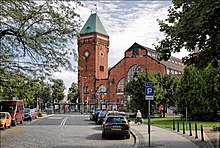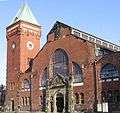Wrocław Market Hall
Wrocław Market Hall (Polish: Hala Targowa we Wrocławiu, German: Breslauer Markthalle) was designed by Richard Plüddemann and built between 1906-08[1] as the Breslauer Markthalle Nr 1, when the city was part of Germany. It is situated by Ulica Piaskowa (Sandstraße), at the junction of Plac Nankiera (Ritterplatz) and Ulica Sw. Ducha (Heiligegeiststraße) close to Market Square, Wrocław and oldest districts of Wrocław. The Hall was built at the same time as another smaller hall with the same interior structure in Ulica Kolejowa. Both buildings were created in order to organize street trading in the city center. Once completed, all street markets were moved into the newly opened halls.

The building was not severely damaged during World War II and continued to be used as originally intended shortly after, whereas the Kolejowa Hall was significantly damaged during the war and finally demolished in 1973. The Wroclaw Hall was completely renovated between 1980-83, and again in 2028-19, and remains one of the biggest produce markets in the city.
Architecture
The hall was renowned for its then-innovative application of reinforced concrete trusses, which was unique in Europe at the time.
Gallery
References
- Praca zbiorowa: Encyklopedia Wrocławia. Wrocław: Wydawnictwo Dolnośląskie 2006



_1.jpg)